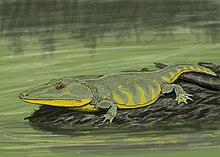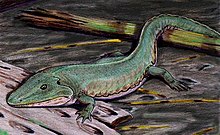Temnospondyli
| Temnospondyli | ||||||||||
|---|---|---|---|---|---|---|---|---|---|---|

Eryops , life reconstruction |
||||||||||
| Temporal occurrence | ||||||||||
| Lower Carboniferous to Lower Cretaceous | ||||||||||
| 340 to 110 million years | ||||||||||
| Locations | ||||||||||
|
||||||||||
| Systematics | ||||||||||
|
||||||||||
| Scientific name | ||||||||||
| Temnospondyli | ||||||||||
| Zittel , 1888 |
The Temnospondyli ( old Greek τέμνειν temnein 'cut' and σπόνδυλος spondylos 'vertebrae') are a taxon of very diverse, small to very large non- amniotic terrestrial vertebrates that lived worldwide during the Carboniferous , Permian and Triassic . Some forms lived up to the Lower Cretaceous . The animals lived fully aquatic in fresh water, amphibious or terrestrial , one group lived near the coast in the sea ( marine ). Their fossils have been found on every continent. It is discussed whether the ancestors of today's amphibians can be found among the Temnospondyli , or whether they became extinct without offspring.
Development history
During the Carboniferous, there were original, medium-sized ( Dendrerpeton ) or large ( Cochleosaurus , over 1.5 meters long) semi-aquatic forms. Other, more advanced genera such Limnerpeton , were small and similar to today's tailed amphibians . Branchiosaurus and its relatives retained their outer gills throughout their lives and resembled the modern axolotl .
During the Upper Carboniferous and Early Permian, different groups developed stronger spines and legs. They adapted to life on land ( Cacops ) or lived as large, clumsy carnivores ( Trematops , Eryops ) in a semi-aquatic manner.
Archegosaurus had a long snout and, although not armored, looked very much like today's crocodiles .
Relatives of this group also include Prionosuchus from Brazil , which was 9 meters long and was the largest non-amniotic terrestrial vertebrate.
During the late Permian, land-dwelling forms became extinct due to increasing drought and competition from reptiles, but aquatic and amphibious forms continued to exist , including Melosaurus from Eastern Europe.
Some of the temnospondyli who lived in the lakes and rivers of the late Permian became more and more adapted to the constant aquatic life. The vertebrae grew weak, the legs small and rudimentary, the heavy skull large and flat, with its eyes turned up. These types include the classic stereospondyli and related types. During the Triassic period, these animals ruled freshwater ecosystems and evolved into small and large forms. During the early Triassic, a group of long-snouted fish-eaters, the trematosaurs, even adapted to marine life.
The Capitosauroidea consisted of medium-sized and very large forms, with lengths of 2.3 to 4 meters, e.g. B. Paracyclotosaurus and Cyclotosaurus . The largest genus, Mastodonsaurus , had an extraordinarily large, flat skull over a meter long. These animals probably spent most or all of their lives at the bottom of the water. They caught their prey by suddenly lifting their upper jaw. Smaller amphibians and fish were sucked into the mouth.
In the late Triassic there lived the superficially very similar, up to 1.5 meters long Metoposauridae and the strange, over a meter long and broad-headed plagiosaurs that had external gills .
The mass extinction about 200 million years ago at the end of the Triassic survived only two groups from Gondwana , the Brachyopidae and the Chigutisauridae . Both groups produced large forms during the following Jurassic , the Brachyopidae in China and the Chigutisauridae in Gondwana.
The youngest known Temnospondyle was Koolasuchus from the Middle Cretaceous Period of Australia. He likely lived in rift lakes where winters were so cold that possibly competing crocodiles were avoiding the habitat. With a length of 5 meters he was one of the largest representatives of this group.
Systematics
-
Temnospondyli (Batrachomorpha)
- Limnarchia
- unnamed monophylum
- Dendrerpetontidae
-
Euskelia
- Eryopidae
-
Dissorophoidea , unnamed monophylum in Benton 2007
- Dissorophidae
- unnamed monophylum
literature
- Michael J. Benton : Paleontology of the vertebrates . 2007, ISBN 3-89937-072-4 .
- Robert L. Carroll : Paleontology and Evolution of the Vertebrates . Thieme, Stuttgart 1993, ISBN 3-13-774401-6 .
Individual evidence
- ↑ Huttenlocker, Adam. 2007: Dissorophoidea Bolt 1969. Version March 12, 2007. in The Tree of Life Web Project
Web links
- Steyer, Jean-Sébastien and Michel Laurin. 2009: Temnospondyli. Version April 04, 2009. in The Tree of Life Web Project
- Michel Laurin and Jean-Sébastien Steyer: Phylogeny and Apomorphies of Temnospondyls. in The Tree of Life Web Project
- Palæos: Temnospondyli: Overview



